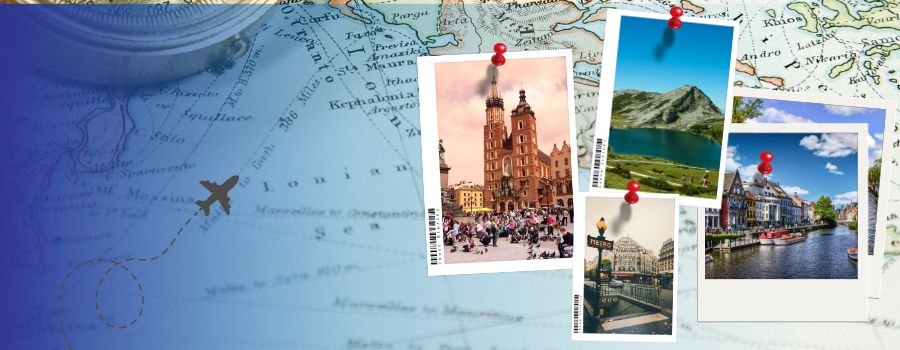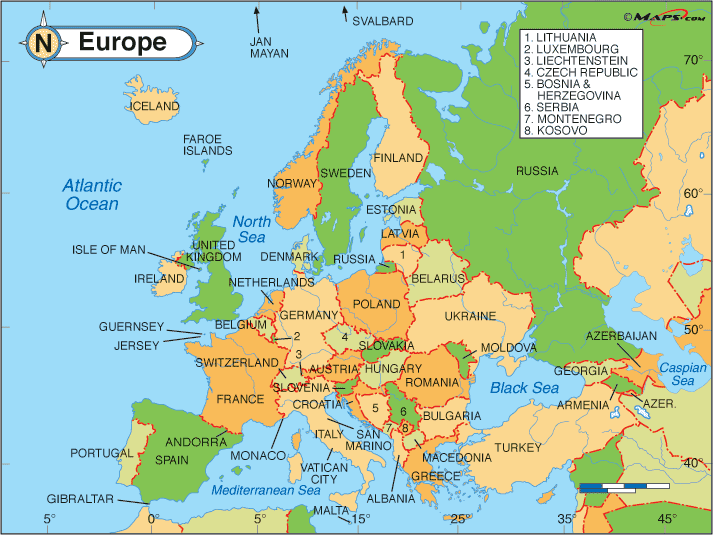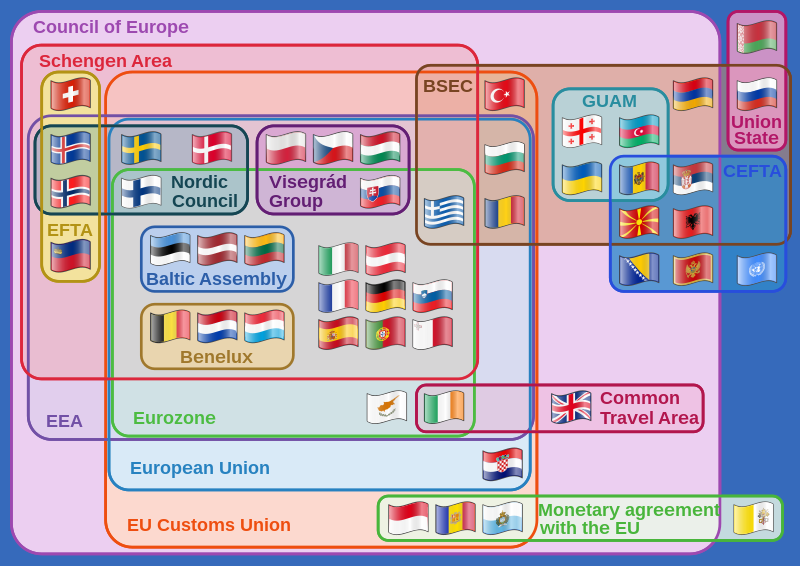- News >
- Number and List of Countries in Europe
Number and List of Countries in Europe

Europe is a continent located in the Northern and Eastern Hemispheres, sharing its landmass with Asia and Africa. It is the second smallest continent on Earth. Europe is surrounded by the Arctic Ocean to the north, the Atlantic Ocean to the west, the Mediterranean Sea to the south, and Asia to the east.
Notable geographical features in Europe include the Italian peninsula extending from the southern Alps to the central Mediterranean Sea, the Balkan Peninsula in Southeast Europe, and the Fennoscandian Peninsula in the north. Various water bodies such as the Ural Mountains, the Ural River, the Caspian Sea, the Greater Caucasus, the Black Sea, and the Turkish Straits separate Europe from Asia.
While popular countries like the UK, Germany, France, and Italy are well-known, Europe is home to many lesser-known countries that have much to offer.
Number of Countries in Europe
Europe is geographically divided into four main regions: Northern Europe, Southern Europe, Eastern Europe, and Western Europe. The United Nations recognizes 50 countries in Europe, which are further grouped based on their geographical regions and subregions. It's worth noting that some countries in these regions may have limited international recognition, while others have dependencies or territories with autonomy. Furthermore, Europe shares certain countries with Asia, known as transcontinental countries.

European Countries: A List of Nations in Europe
European countries can be classified into four main geographical regions: [regions]. These countries have been segregated based on their geographical location, including de facto countries and territories.
Northern European Countries
These countries, including Norway, Sweden, and Denmark, share geographical proximity and similar cultural traits in the northern part of Europe.
- Denmark
- Estonia
- Finland
- Iceland
- Ireland
- Latvia
- Lithuania
- Norway
- Sweden
- United Kingdom
Southern European Countries
Comprising nations like Italy, Spain, and Greece, these countries showcase a distinct Mediterranean lifestyle and rich historical heritage.
- Albania
- Andorra
- Bosnia and Herzegovina
- Croatia
- Cyprus
- Greece
- Italy
- Malta
- Montenegro
- North Macedonia
- Portugal
- San Marino
- Serbia
- Slovenia
- Spain
- Turkey
- Vatican City
Eastern European Countries
Countries such as Russia, Poland, and Ukraine form the eastern part of Europe and exhibit unique cultural, political, and historical characteristics.
- Belarus
- Bulgaria
- The Czech Republic or Czechia
- Hungary
- Moldova
- Poland
- Romania
- Russia
- Slovakia
- Ukraine
Western European Countries
Countries like France, Germany, and the United Kingdom, located in the western part of Europe, have significant influence on global politics, economy, and culture.
- Austria
- Belgium
- France
- Germany
- Liechtenstein
- Luxembourg
- Monaco
- Netherlands
- Switzerland
Transcontinental Countries in Europe
- Armenia
- Azerbaijan
- Georgia
- Kazakhstan
De Facto Countries in Europe
These regions, including Transnistria and Abkhazia, have declared independence but are not universally recognized as sovereign states, leading to complex geopolitical situations.
- Abkhazia
- Artsakh
- Donetsk
- Kosovo
- Luhansk
- Northern Cyprus
- South Ossetia
- Transnistria
Dependencies and Territories in Europe
European territories like Gibraltar, Faroe Islands, and French Guiana are dependencies or overseas territories of other countries, often showcasing unique characteristics and governance arrangements.
- Sovereign Base Areas of Akrotiri and Dhekelia - UK
- Åland - Finland
- Bailiwick of Guernsey - UK
- Bailiwick of Jersey - UK
- Faroe Islands - Denmark
- Gibraltar - UK
- Greenland - Denmark
- The Isle of Man - UK
- Svalbard - Norway
What countries are considered part of the Nordic region?
When discussing the Nordic countries, it is common for people to mistakenly confuse them with the Scandinavian countries. In order to clarify this distinction, let's delve into the differences between these two regions.
Nordic Countries:
The Nordic countries encompass a cultural and geographical region located in northern Europe. They share similar lifestyles, histories, religions, and social structures, giving rise to a sense of shared identity.
What sets the Nordic countries apart is their linguistic diversity, with three distinct language communities. The countries and other territories that comprise the Nordic region are:
- Denmark
- Finland
- Iceland
- Norway
- Sweden
In addition to these countries, the Nordic region also includes various territories and regions such as the Faroe Islands, Greenland, Åland, Jan Mayen, Svalbard, Bouvet Island, Peter I Island, and Queen Maud Land.
Scandinavian Countries
Scandinavian Countries, also known as the Nordic countries, encompass Denmark, Norway, Sweden, and the Scandinavian Peninsula. This geographical region stretches from mainland Norway and Sweden to the northwest corner of Finland. However, it's worth noting that the term "Scandinavia" is sometimes used interchangeably with "Nordic countries," which includes additional territories beyond the Scandinavian Peninsula.
Apart from the Scandinavian Peninsula, the Nordic territories also include Bouvet Island, Greenland, Jan Mayen, and Svalbard, which are not considered part of Scandinavia.
The definitions of these terms can be a bit unclear, leading to confusion. While there may be slight distinctions between the two terms, they essentially refer to the same concept.
Comparison of Schengen Member States and European Union Member States
Understanding the distinction between two entities, namely the Schengen Area and the European Union (EU), is crucial before delving into which countries belong to each.
It is important to note that several countries are members of both the Schengen Area and the European Union (EU).
Schengen Area
The Schengen Area was established through the signing of the Schengen Agreement by numerous European countries. This agreement aimed to facilitate the free movement of individuals among the participating nations, effectively creating a borderless zone within the Schengen Area.
The Schengen Agreement led to the elimination of passport checks and other forms of border control at the mutual borders of the signatory countries. This means that individuals can travel freely between these nations without undergoing extensive immigration procedures.
Currently, the Schengen Area encompasses 26 countries, namely:
- Austria
- Belgium
- Czech Republic
- Denmark
- Estonia
- Finland
- France
- Germany
- Greece
- Hungary
- Iceland
- Italy
- Latvia
- Liechtenstein
- Lithuania
- Luxembourg
- Malta
- Netherlands
- Norway
- Poland
- Portugal
- Slovakia
- Slovenia
- Spain
- Sweden
- Switzerland
These countries have come together to promote closer integration and facilitate seamless travel within the Schengen Area.
European Union (EU)
The European Union (EU) is a union of multiple European countries, established with the aim of fostering political and economic integration. It operates under a standardized legal system that governs a unified internal market, ensuring consistent trade, agriculture, fisheries, and regional development policies.
One of the fundamental principles of the EU is the free movement of citizens, goods, services, and capital among its member states. Currently, the EU consists of 27 member states, forming a cohesive political and economic bloc. These member states are:
- Austria
- Belgium
- Bulgaria
- Croatia
- Cyprus
- Czech Republic
- Denmark
- Estonia
- Finland
- France
- Germany
- Greece
- Hungary
- Ireland
- Italy
- Latvia
- Lithuania
- Luxembourg
- Malta
- Netherlands
- Poland
- Portugal
- Romania
- Slovakia
- Slovenia
- Spain
- Sweden
The following diagram illustrates the relationships between various multinational European organizations and agreements:
[Diagram: Relationships between multinational European organizations and agreements]
Please note that the diagram provides a visual representation of the interconnectedness between different entities within Europe.

Additionally, the Schengen Area has implemented the European Travel Information and Authorization System (ETIAS) for countries exempt from visas.
Please note: In the near future, visa-exempt countries will be required to register with ETIAS. We strongly recommend referring to our comprehensive blog post on ETIAS or exploring further information about the Schengen Area.
Languages Spoken in Europe
Europe is home to a rich linguistic tapestry comprising approximately 225 indigenous languages. Here are some notable examples:
- Germanic Languages: German, Dutch, Bavarian, Swedish, Danish, Norwegian, Flemish, and Afrikaans.
- Slavic Languages: Russian, Ukrainian, Polish, Belarusian, Czech, Bulgarian, Croatian, Serbian, Slovak, and more.
- Baltic Languages: Lithuanian and Latvian.
- Celtic Languages: Welsh, Cornish, Gaelic, and Breton.
In addition, the European Union recognizes 24 official languages, namely Bulgarian, Croatian, Czech, Danish, Dutch, English, Estonian, Finnish, French, German, Greek, Hungarian, Irish, Italian, Latvian, Lithuanian, Maltese, Polish, Portuguese, Romanian, Slovak, Slovenian, Spanish, and Swedish.
There are also other significant languages spoken in Europe, such as Albanian, Armenian, Basque, and Hellenic Turkish, among others.
Exciting Activities to Explore in Europe
Europe offers a plethora of captivating experiences for vacationers. Whether you are drawn to the iconic Eiffel Tower in Paris or the rich historical sites in Athens, Europe promises an unforgettable journey. Instead of merely rattling off a list of destinations, I encourage you to explore the diverse range of Europe tour packages, allowing you to curate a personalized and remarkable holiday experience.
With its remarkable blend of history, art, and culture, Europe beckons travelers from all corners of the globe. Marvel at the architectural wonders of Rome, soak in the romantic ambiance of Venice's canals, or delve into the vibrant nightlife of Barcelona. Traverse the picturesque landscapes of the Swiss Alps or embrace the magical charm of the Scottish Highlands. The options are endless.
For the culturally inclined, Europe boasts a treasure trove of renowned museums, such as the Louvre in Paris, the British Museum in London, and the Prado Museum in Madrid. Immerse yourself in the works of the masters, from Da Vinci's enigmatic Mona Lisa to Van Gogh's mesmerizing Starry Night.
Food enthusiasts will be tantalized by Europe's culinary delights. Sample delectable pastries in Vienna, indulge in authentic pasta dishes in Italy, or savor mouthwatering tapas in Spain. Each region offers a distinct gastronomic adventure, showcasing the rich flavors and traditions of European cuisine.
Nature enthusiasts can revel in Europe's breathtaking landscapes. Embark on a scenic hike along the rugged cliffs of Ireland's Wild Atlantic Way or cruise through the majestic Norwegian fjords. Admire the awe-inspiring beauty of Iceland's geysers and waterfalls or bask in the Mediterranean sun on the stunning Greek islands.
Moreover, Europe's vibrant festivals and events provide an immersive cultural experience. Witness the colorful spectacle of Carnival in Venice, revel in the lively Oktoberfest celebrations in Munich, or soak in the vibrant atmosphere of the Running of the Bulls in Pamplona.
To make the most of your European adventure, consider exploring various tour packages tailored to your interests and preferences. Whether you desire a romantic getaway, an adventurous expedition, or a cultural exploration, Europe offers an abundance of options to suit every traveler.
So, begin your journey of discovery and embark on a European vacation that will leave you with memories to cherish for a lifetime.
